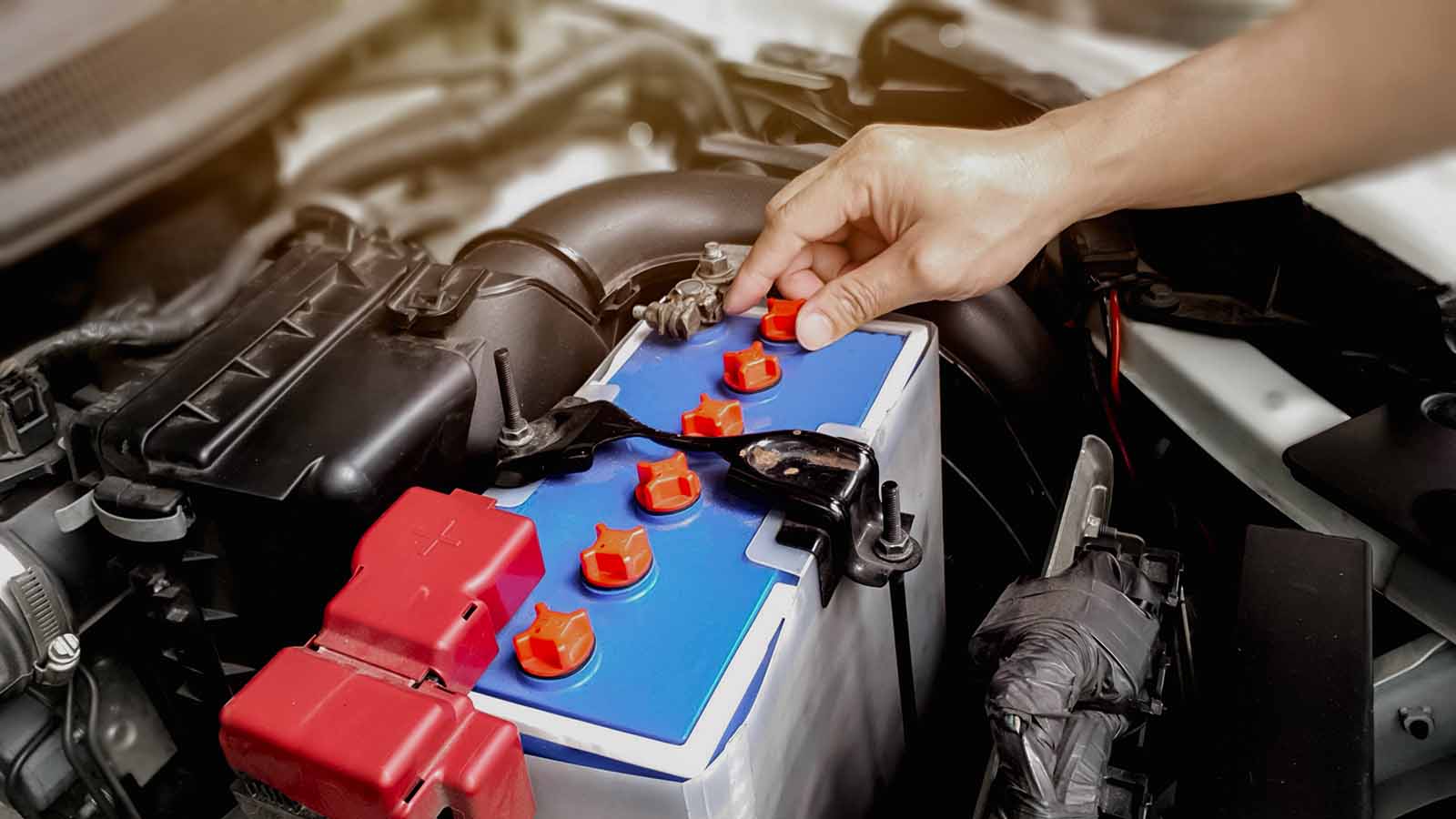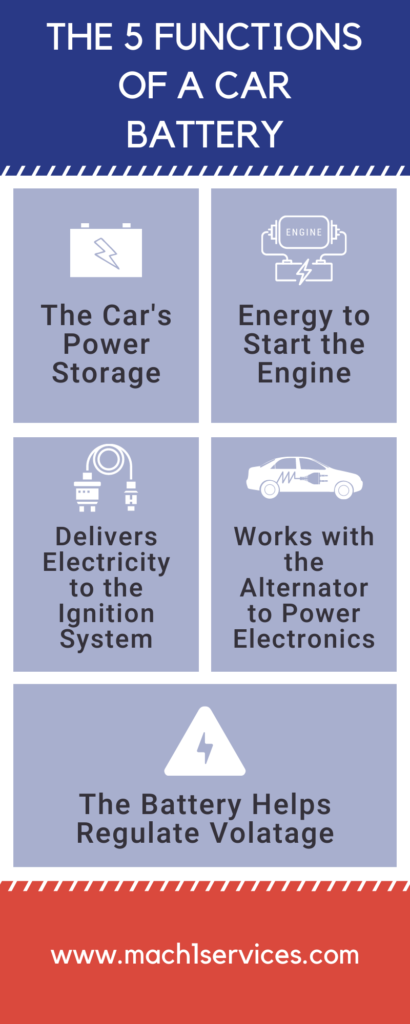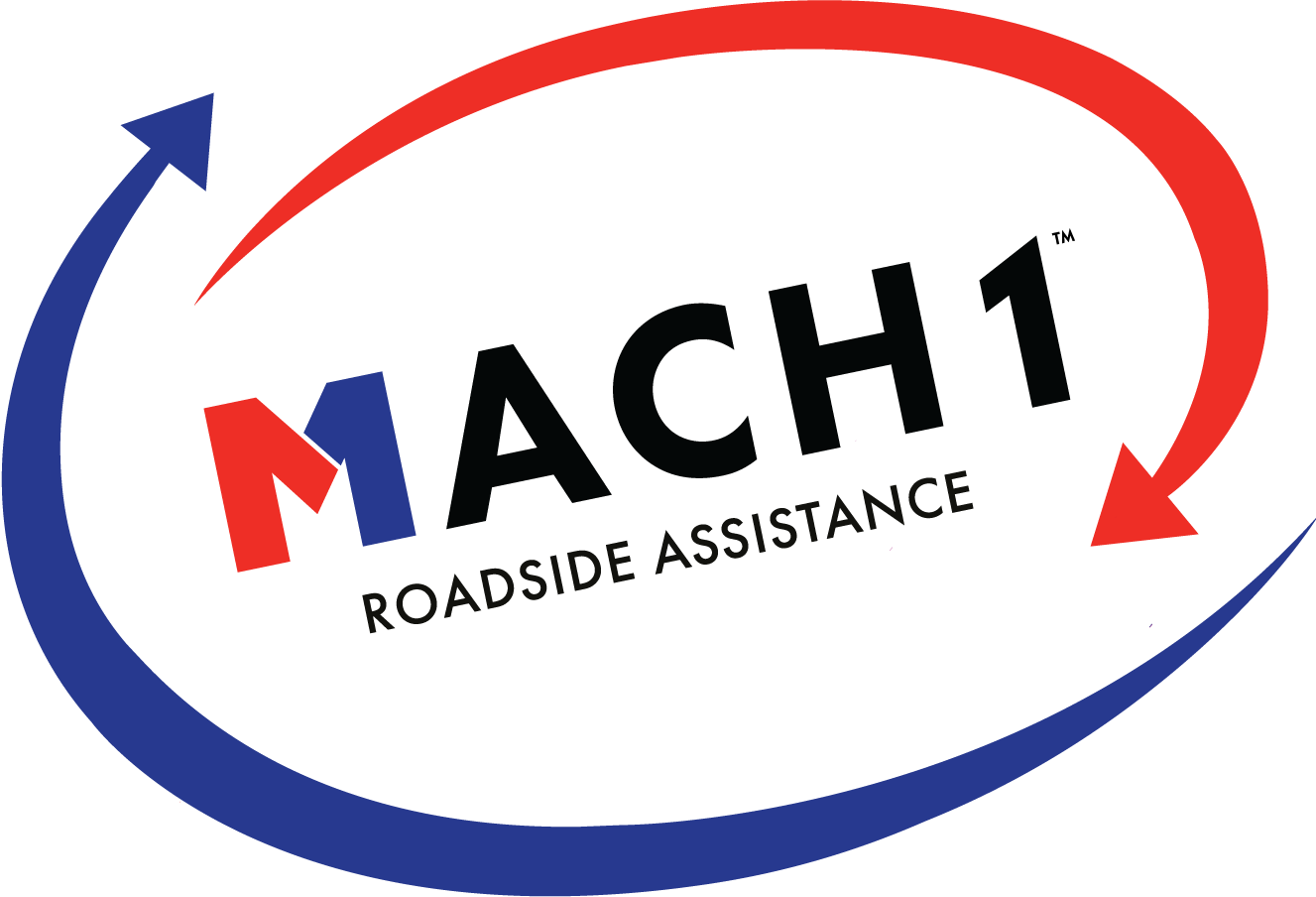
09 Oct The 5 Functions of a Car Battery
Did you know there are many more functions of a car battery than just starting your car? Understanding how a car battery works can be helpful for many reasons. The battery in your car is part of a fine-tuned, integrated system that supports your car’s processes. If you thought it was just a simple chunk of equipment, think again.

Let’s take a look at the five functions of a car battery and discover just how sophisticated a car battery is.
- The car’s power storage A car battery is the car’s power bank. The often rectangular, box-shaped battery is the storehouse for the power your vehicle needs to start the motor and maintain a charge.
On the outside, a car battery just looks like a boring plastic block with some connectors on the top. But this plastic outer shell is quite durable and usually acid-resistant, to protect the complex inner workings and materials inside that do the magic. The inside of the battery is home to a chemical solution (usually sulfuric acid) and layers of lead and lead dioxide plates, which react with the acid to create energy.
There are different voltage levels available for car batteries, the most common being 12 volts. A standard 12-volt car battery has six cells, which each produce 2.1 volts in a fully charged state. Every decrease of .2 volts in a battery’s charge equates to roughly a 25% loss of power. Therefore, it is critical to maintain proper battery charge at all times.
There are some things to be aware of that might drain your battery and decrease your power stores. You certainly don’t want to find yourself running late for work one morning, and your car won’t start needing a dead battery recharge. Watching out for these hazards will reduce the chance that you’ll be surprised by a dead battery:
- Don’t leave your headlights on! Most newer model cars have automatic headlights, so paying attention to this might not even be on your radar. But imagine, you’re driving someone else’s car, or a courtesy vehicle while yours gets serviced, and it doesn’t have automatic headlights. You could forget to turn them on, and you could forget to turn them off! This will drain the battery fairly quickly.
- Make sure all your doors are shut, interior and exterior, and that no lights or electronics are running. These things are called a parasitic draw, and they slowly leech the power out of a battery when the car is off because there’s no active recharging coming from the alternator.
- Regularly check (or have your mechanic regularly check) your battery connections and terminals. Over time they can jiggle loose or even start to build up corrosion. This is easily avoidable but can cause damage to your car’s electrical system if you stall out during your commute.
- If at all possible, don’t leave your car sitting too long in the extreme heat or cold. Whether you park it in a garage or you periodically start it up and give the battery some charge, any battery that is moderately aged may start to weaken in harsh temperatures, at either end of the thermometer.
- If you notice that your car has trouble starting or won’t start after you’ve just driven it somewhere, for example – you drove to the supermarket and had no problem, but when you returned to your car with your bags, the car wouldn’t start – you could have a bad alternator.To start your car, you need battery power. But while your car is on, the alternator recharges the battery. So if a single drive seems to drain the life from your battery, chances are it’s not getting the charge it needs while driving, and you might need a new alternator.
- Simple factors like age and overuse can wear a battery out, too. If it’s been 3-5 years without being checked or replaced, start paying a little more attention to it and maybe have it tested.
- Energy to Start The EngineWith its power storage, the battery contains enough power to start the engine. The acid and the plate materials (lead and lead dioxide) interact in a specific order to create positive and negative charges as well as byproduct materials. These components create a chemical reaction which generates electrons – or electricity – that travels out of the battery to start your car.Fun fact: if you’ve ever used a car charger to boost your weak car battery, the reason it works is because this sequence of events is reversible. The charger can put the energy back into your battery.Standard 12-volt car batteries have varying degrees of power strength. The CCA (or cold-cranking amperes) rating indicates how well the battery will be able to start an engine in the cold. Depending on the type of battery you have and the climate you live in, you may or may not have the necessary amount of battery power to crank your car’s engine.
Many people think “more is better,” so they automatically assume the battery with higher CCA is the right one. The right CCA for your vehicle largely depends on the climate you live in. High CCA is great for colder climates where engines might be harder to start. Batteries with higher CCA have had more plates, and more solution added.
But this design isn’t one-size-fits-all. Adding more plates means they have to be thinner and closer together. In high-heat climates, this isn’t ideal because it can lead to corrosion and loss of liquid. CCA is a rating best suited for North America and Europe, where it gets cold frequently. In other parts of the world where it’s mostly hot all the time, MCA and HCA are a better gauge.
It is important to note that a battery’s available power increases in warmer temperatures because chemical reaction rates are higher. CCA (cold-cranking amps) measures the current available at -18°C. MCA (marine cranking amps) measures the available power at 0°C, which is more helpful in warmer climates where freezing weather is rare. Battery cranking power increases by roughly 20% under this rating method.
Then there’s HCA (hot cranking amps), which measures the power available at 26.7°C, or 80°F. A good rule of thumb is, the warmer the conditions, better the battery will be able to crank. HCA would be the ideal rating method to use in arid and tropical climates.
Still, it’s not as simple as choosing a battery based on the CA measurement that is most suitable for your climate. Every vehicle has different loads – or the amount of current needed from the battery. Size is not necessarily the best indicator, either. A smaller car’s engine may need as much cranking power as a large SUV because it has to be cranked faster.
Each of the vehicle’s options, from power windows to heated seats, places a demand on the current needed from the battery. Fuel type is a factor as well. So, just because you live in a cold climate and you have a newer vehicle with all the bells and whistles, does that mean you should choose the battery with the highest possible CCA you can find?
Maybe not. Higher CCA is linked to possible starter damage and can shorten the life of a battery. Ask your local auto body shop which battery will provide you with the best balance of power and endurance while sustaining all of your car’s functions in the weather you most typically experience.
- Delivers Electricity to the Ignition SystemWhen you turn on your car’s ignition, whether you do it by turning a key or pushing a button, you send a signal to the battery, telling it to initiate that chemical reaction we just talked about in order to produce enough electrical current to get the starter to power up the engine.
Basically, the battery’s job in this part of the process is to exude a strong, short burst of power. The coil then generates the high voltage necessary to crank the starter, reach the spark plugs via a distributor, and ignite the fuel inside the combustion chambers.
There are various types of ignition systems, but most of the road vehicles we know today have a mechanically timed ignition consisting of multiple parts that complete a circuit. There are many processes working in tandem, somewhat simultaneously, and it happens very quickly, but it starts with the battery. We all enjoy the ease and convenience of modern automobiles, thanks to a simple battery that acts as the catalyst to a series of fascinating processes and exchanges of energy.
- Works With The Alternator to Power Electronics
You may have already known those first three functions, but were you aware that the battery also works in tandem with the alternator to power your vehicle’s electronic processes?
That’s right — the alternator (whose job it is to “alternate” the current and turn mechanical energy into electrical energy) is the component that keeps your radio, air conditioning, USB and auxiliary-connected devices, and lights running. But the battery has to provide reliable backup in the event that the alternator becomes overwhelmed. When too many processes are draining the alternator, the battery sustains the power flow by providing an energy boost.
Essentially, the alternator is a generator. The battery is what provides the initial burst of energy to the starter so that it’ll crank the engine. Still, the alternator is what keeps the electronics going and charges the battery. That’s why a car battery generally won’t go dead while the car is being driven because it’s actively charged by the alternator. (But if you ever have a dead battery, don’t worry Mach1 Services is here to help!)
If you’re a visual person, you may want to understand exactly what happens under the hood of your car to get this generator (alternator) going. There’s a wheel on the alternator that gets turned once the car’s engine starts running. The engine spins a set of wheels, which then spin the wheel on the alternator. It’s like a game of Mouse Trap.
With its stator, rotor, diodes, voltage regulator, and cooling fan, an alternator is constantly working while your car is running to maintain the energy flow through the engine and your vehicle.
Fun fact: Although alternators were used as early as World War II, they weren’t standard on production cars until the 1960s.
Alternators can last up to seven years in good conditions and with proper use, but they are also one of the most common reasons for “car trouble.” If the alternator dies, your car will drain the battery’s power fairly quickly and then die.
Alternator repairs can cost anywhere from $300 to over $1,500, depending on the vehicle and the exact cause of the problem. Warning signs of alternator trouble (things to look out for):
- Dashboard battery icon is lit, or system message displays “service battery charging system”
- Dimmer lights than usual (both interior and headlights) and heated/cooled seats not working as well
- Grinding sounds – alternators have a lot of parts, like pulleys, bearings, and belts that can wear out over time
- The smell of burning rubber – this could be the alternator’s belt getting melted by some other component that’s out of alignment
- The battery helps regulate voltageIt’s a well-known fact that power surges can damage electronics. Well, your battery prevents sudden spikes in power from damaging your car’s internal computer and ignition system from damage. Along with various types of fuse elements and circuit protection devices used throughout the vehicle, a car’s battery can help to regulate the power that goes to the electrical systems.Alternators have voltage regulators that convert the electrical current into a type of current that won’t damage the car’s electronics. The purpose of this regulator is to maintain the highest possible amount of voltage in the circuit consistently. It can signal the alternator to generate more or less power according to the vehicle’s needs. Any excess power charges the battery.Having the battery to rely on as a backup for the alternator is what protects your car’s systems. If you were to suddenly disconnect the alternator from the battery, the resulting voltage surge would likely damage your vehicle. But the completed circuit, with the battery in place, ensures a slower, more regulated change in power levels if your alternator dies and your battery takes over.
And if you ever wonder how much a jump start costs and who to call, contact Mach1. We are here to help!
